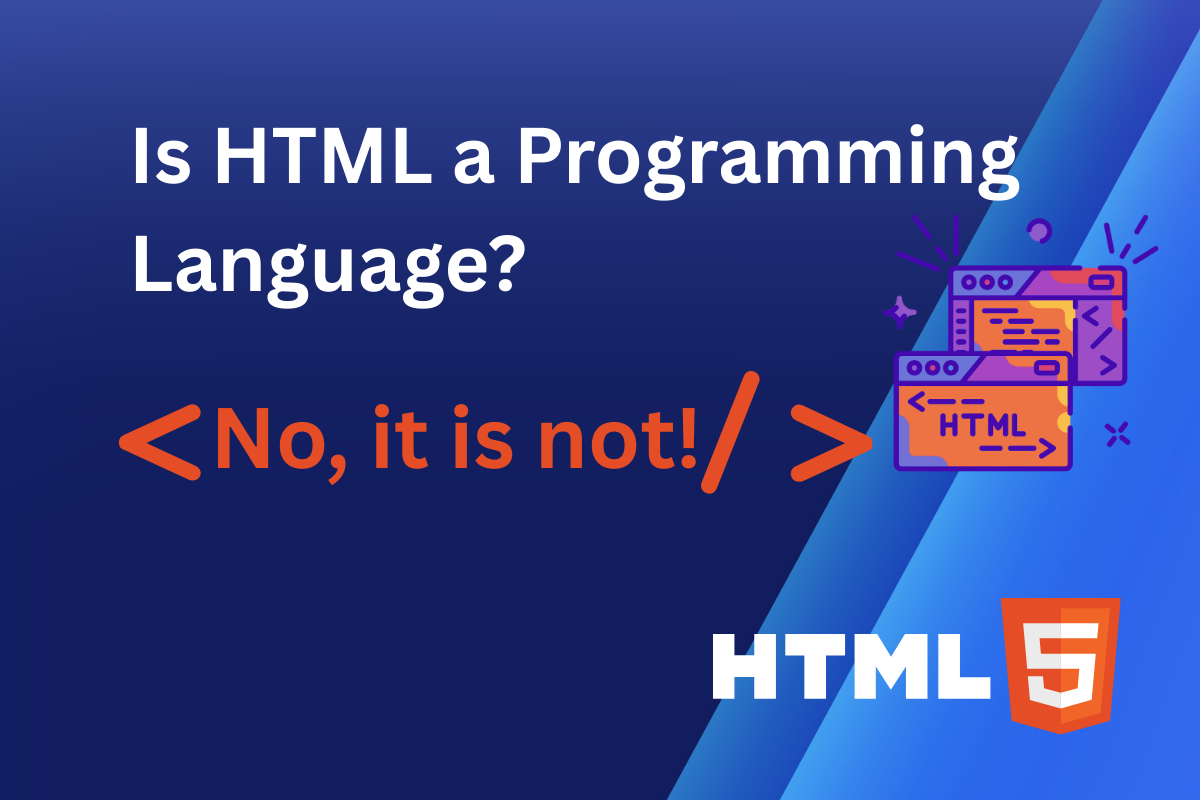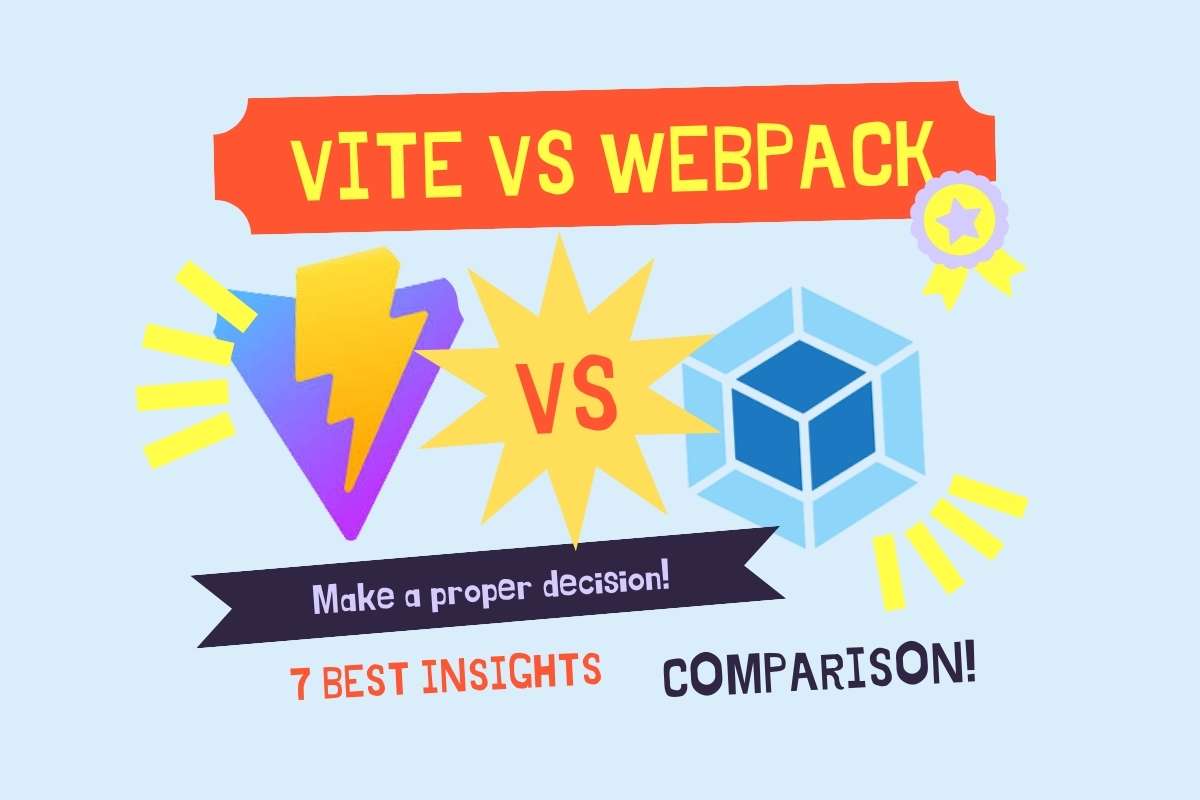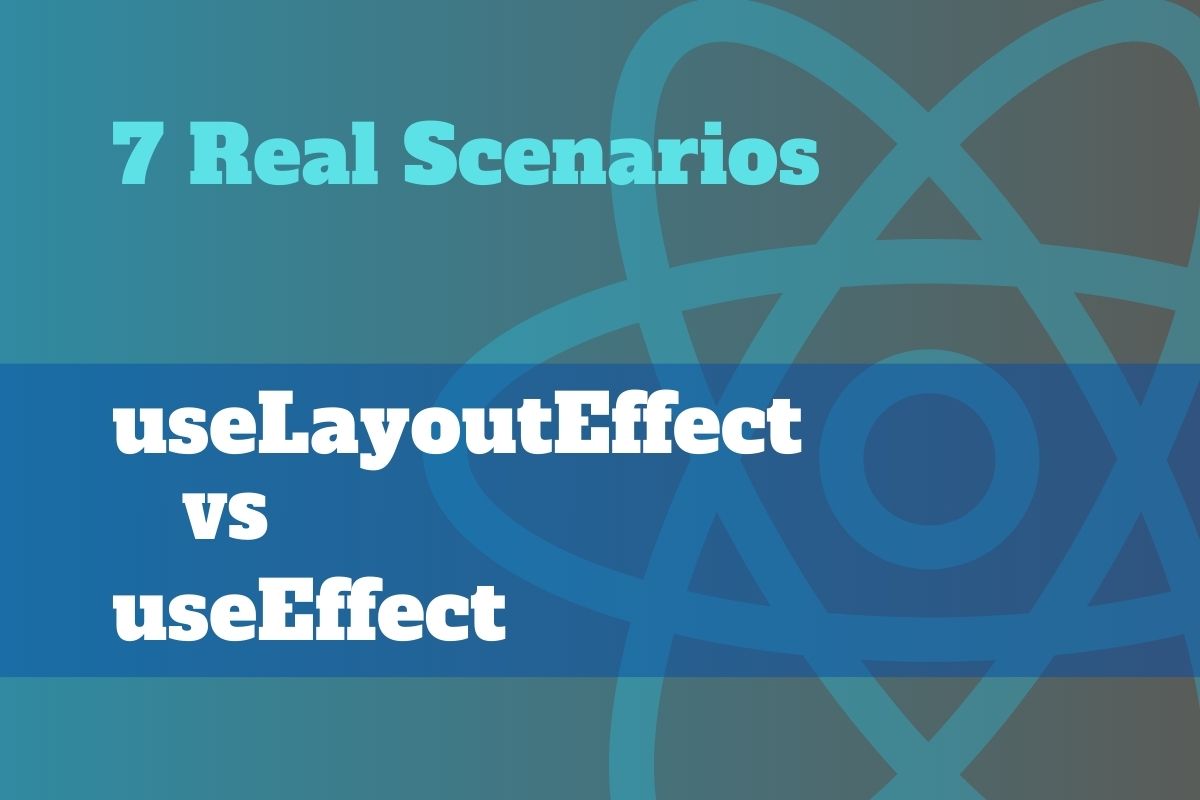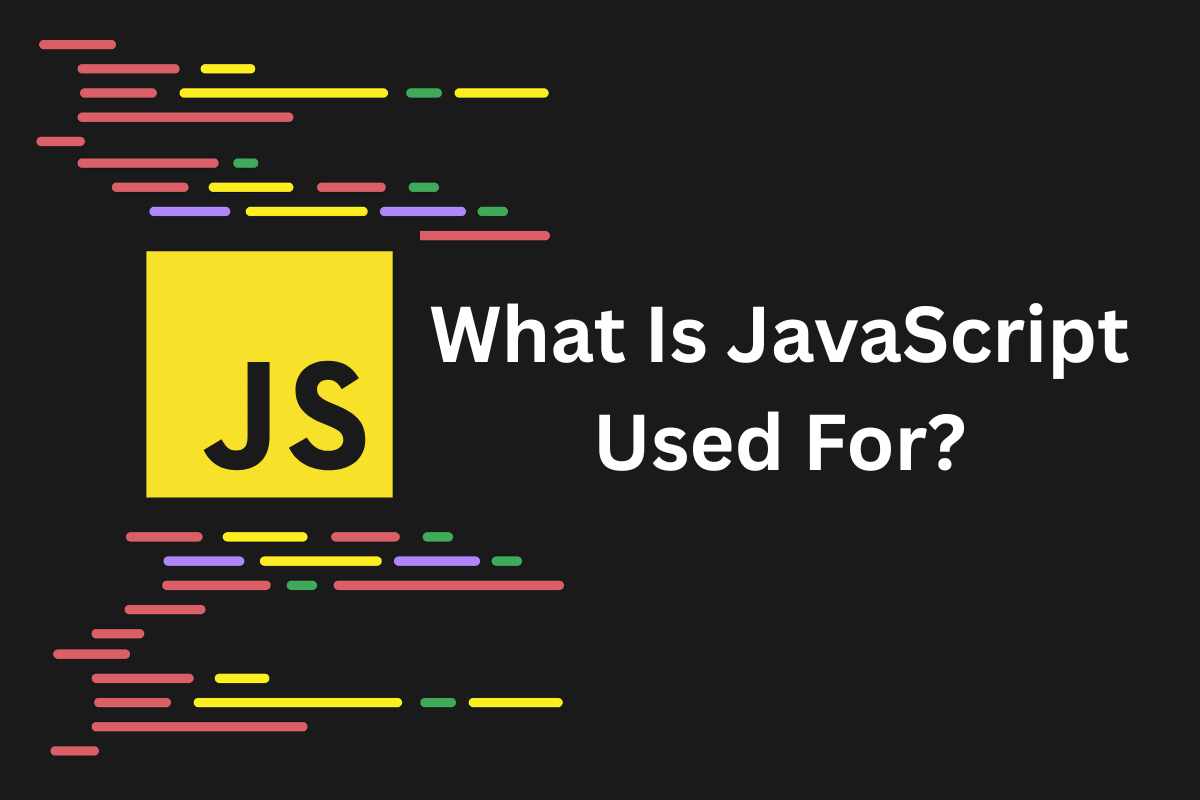Is HTML a programming language or just the Internet’s “skeleton”? I’ve taught JavaScript and React for years. This argument follows me everywhere – job interviews, Stack Overflow threads, Reddit battles. It’s not just academic either. How you answer affects your resume and career credibility.
Over 17 million companies use HTML (HyperText Markup Language) worldwide. Yet most senior developers won’t call it programming!
So let’s get real — HTML is powerful, necessary, and cool. But there are 3 reasons it’s NOT programming!
What Exactly Is HTML? Understanding the Fundamentals
HTML is a markup language, not a programming language. Unlike a programming language (Java or JS), a markup language doesn’t “do” anything. It marks content.
Here’s a tiny chunk of real HTML. Read it (out loud is better!). Those angle brackets (< >) are called tags. They wrap around content to define what it is. The <h1> and <h2> tags create headings. The <p> tag makes a paragraph.
Mess with this code — change the text between the <h1> </h1> or <p> </p> tags, and you immediately see the results.
The <html> tag acts as the container for all your content. It tells the browser “everything inside here is HTML”. The <h1>, <h2>, and <p> tags create different types of content.
Notice how <h1> is bigger than <h2>, and how a paragraph looks different from headings. This visual difference helps users understand your content structure.
How Browsers Understand HTML
When you visit a website, your browser (Chrome, Firefox, Safari) reads the HTML code. It doesn’t “run” the code like a program — it parses it. Then, the browser converts HTML into something called the DOM (Document Object Model).
The browser renders this DOM structure into the visual webpage you see. It’s like following a recipe — the browser reads the HTML instructions and builds the page step by step.
The Three Pillars of Web Development
Meet the web development “holy trinity” — HTML handles structure, CSS styles, and JavaScript adds interactions.
HTML serves as your foundation and frame. HTML creates headings, paragraphs, sections, lists, forms with fields, images, videos, and tons of other elements. HTML tells the browser “put a title here” or “add an icon there.” It’s purely structural.
CSS handles all the pretty stuff — styling. CSS controls colors, fonts, layouts, and animations. Without CSS, websites would look like boring text documents from the 1990s.
JavaScript brings everything to life. It adds interactivity, handles user clicks, processes forms, and creates dynamic content. JavaScript actually IS a programming language as it performs calculations and makes decisions. Learn more about “What Is JavaScript Used For – 8 Powerful Reasons to Know About JS!“
Here’s a simple example — three buttons — each one shows a different layer of web dev.
The first button uses only HTML markup. The <button class="">Only HTML</button> creates a basic clickable element. HTML tells the browser, “put a button here!” It works, but it looks boring with the default styling.
The second button is the same HTML, but now has a little CSS. The button turns blue (background-color: cadetblue), text goes white (color: white), and everything is centered and neat (display: flex). Suddenly, it is a real button you wanna press. But it still does NOTHING when you click.
Now the third one — same HTML and CSS, plus JavaScript. It uses an onclick event, so when you click it, an alert window pops up.
No HTML — no button at all.
No CSS — cheesy look.
No JavaScript — clicking does absolutely nothing special.
Each step builds on the last. HTML gives you the shape. CSS makes it pretty. JavaScript gives it life. Interested in web dev? Read more about “What Does A Front End Developer Do: 7 Core Responsibilities“!
What Even Is a Programming Language?
In computer science, a programming language is a system that lets you write instructions for computers. But most academics also agree that true programming languages must be Turing complete!
A Turing-complete system solves any mathematically solvable problem. It needs three key things:
- Conditional logic — if/then statements.
- Loops or recursion — repeating actions.
- Memory manipulation — storing and changing data.
Most programming languages you know have it all. JavaScript, Python, C++, and even Excel spreadsheets are Turing-complete. Even Minecraft’s redstone system qualifies!
HTML was designed for structuring web content. It CAN’T make decisions, loop through data, or perform calculations on its own. It’s a markup system — useful, but fundamentally different from coding languages.
The 3 Top Reasons Why HTML Is NOT a Programming Language
HTML doesn’t do what real code does. It’s not only about commands or logic — it’s about structure. It doesn’t think. It doesn’t run.
Here are the three reasons why HTML falls into a completely different category.
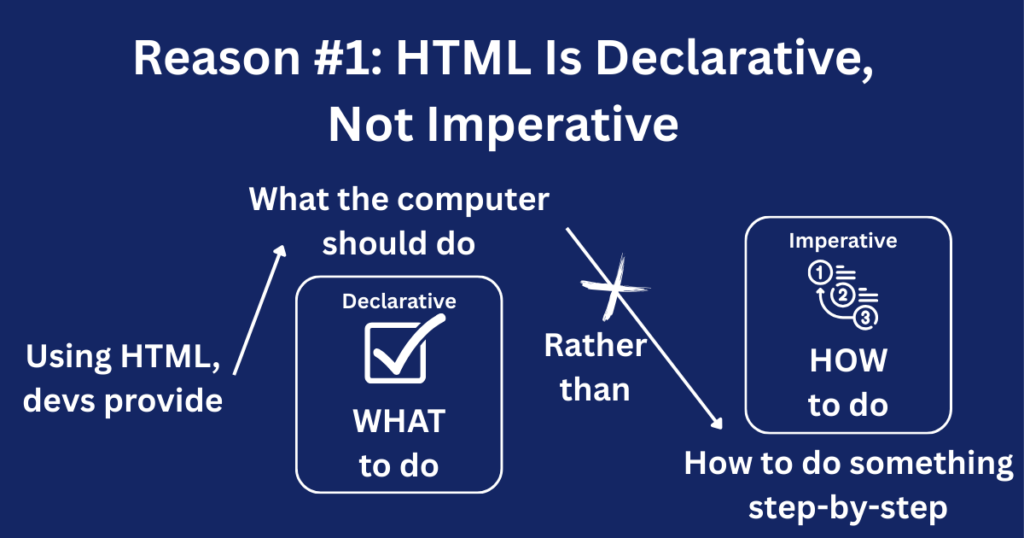
Reason #1: HTML Is Declarative, Not Imperative
Declarative programming tells the computer what you want. Imperative programming tells it how to get there.
HTML describes the desired END result. It doesn’t outline intermediate work steps. When you write <h1>My Title</h1>, you’re saying, “make this a heading.” You’re not telling the browser how to render fonts or calculate spacing.
Imperative or multi-paradigm languages (like JavaScript) work differently. They provide explicit instructions: “create variable, loop through array, check condition, execute action”.
Think of HTML as a config file for the browser, not instructions.
HTML elements are basically declarations. Each tag says “this is a paragraph” or “this is a link“. The browser figures out the rest.
When you write HTML, the browser becomes your interpreter. It reads your declarations and figures out how to display them.
This is why HTML fits the declarative paradigm perfectly. You declare what you want. The system (say, Chrome) handles implementation details.
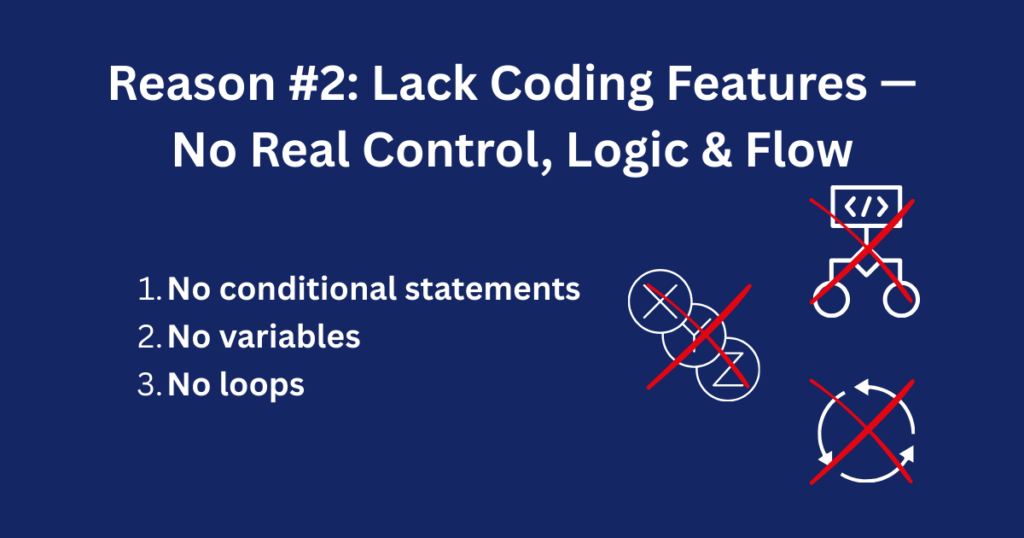
Reason #2: HTML Lacks Coding Features — No Real Control, Logic & Flow
Real programming languages need variables, conditionals, and loops. HTML doesn’t have any of these.
In real programming, you need variables. That’s where you store data like someone’s age: age = 21. You also need if/else statements, like if age is 18 or more, then say “You’re an adult”. HTML can’t do any of that.
HTML simply can’t do any of this stuff. No if. No else. No while. No loops. No variable. Nothing. You can’t even do 2 + 2 in HTML.
The Turing Completeness Problem — Is HTML a Programming Language?
Programming languages must be “Turing complete”. Turing completeness means a system can solve any computational problem.
HTML doesn’t allow for data storage and retrieval, or anything else a programming language does. It’s far from being Turing complete.
Some claim HTML5 + CSS3 is Turing complete. And yeah, even if CSS3 animations barely pass the Turing test, but HTML alone? Nope.
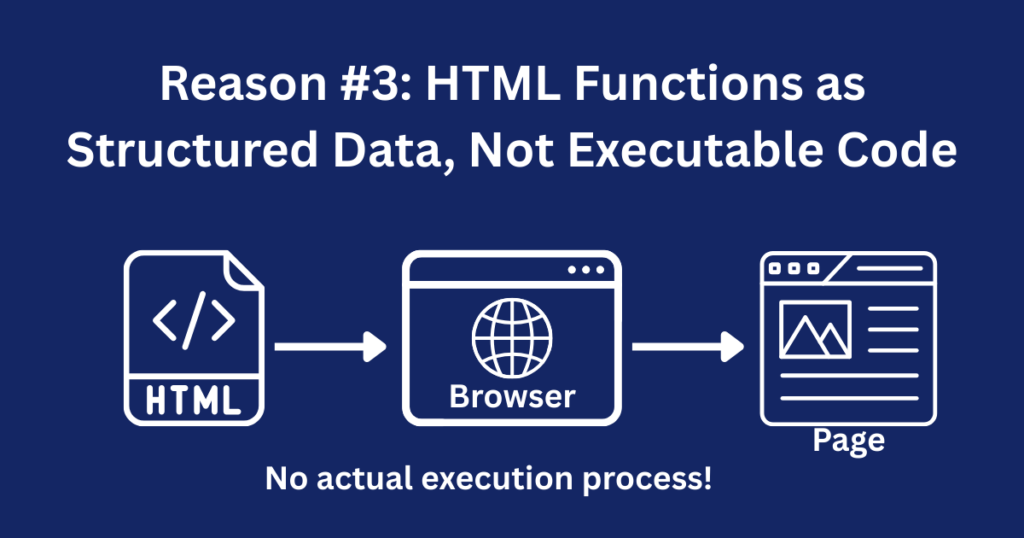
Reason #3: HTML Functions as Structured Data, Not Executable Code
When your browser receives HTML, it DOESN’T “execute” the code. Instead, it parses and renders the markup into visual elements. This is fundamentally different from executing programming code.
HTML shares more similarities with XML and Markdown than with JS or PHP. All three are markups for content organization:
| Language | Purpose | Executable? |
|---|---|---|
| HTML | Web content structure | No |
| XML | Data storage/transport | No |
| Markdown | Text formatting | No |
XML and JSON handle data transmission between servers. HTML handles content presentation for browsers. Neither performs calculations NOR contains programming logic.
Conclusion: Is HTML a Programming Language?
Nope — HTML ain’t a programming language (not by a long shot). Here’s why:
- It can’t do anything — no logic, no loops.
- It only describes stuff.
- It doesn’t run code — zero interaction.
But HTML is still clutch. It’s the backbone of every webpage. Sooo, HTML ain’t a language like Python or JavaScript. But it’s still super valuable.
Keep learning. Keep building. And show respect in the comments — no flame wars, please!
FAQ — Is HTML a Programming language?
Q: Is HTML a programming language or a markup language?
A: HTML is definitely a markup language, NOT a programming language! The “M” in HTML stands for “Markup” — HyperText Markup Language. It structures content but can’t perform calculations or logic operations.
Q: Can HTML store variables like other programming languages?
A: Nope! HTML can’t store variables at all!! HTML describes how content should look and be organized on web pages.’
Q: Is HTML5 different from regular HTML in terms of programming?
A: HTML5 is still just a markup language, even with new features and semantic elements. You’d need JavaScript (or other languages) for ACTUAL functionality.
Q: Do I need HTML to become a real programmer?
A: HTML is essential for web development but won’t teach you programming concepts! It’s like learning the alphabet before writing novels. Read more in my “Complete Guide on How To Get Into IT in 2025!“
Conclusion — Is HTML a Programming Language?
Nope — HTML ain’t a programming language (not even close). I mean, I’ve been teaching JavaScript and React for years, and trust me, HTML just doesn’t play in the same league. It’s markup. Pure structure. That’s it.
It can’t run logic — no ifs, no loops, no math. It doesn’t store data. It doesn’t “execute.” All it does is tell the browser what stuff is (like “this is a heading” or “that’s a paragraph”). Pretty important, but not “programming.”
So, is HTML a programming language? Short answer — nah. Long answer — it’s a markup system that gives your content bones (think “skeleton”). Without HTML, you have no web to style, no buttons to click, no page at all.

